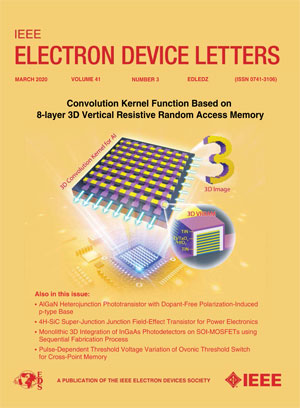The Impact of Through Silicon Metal (TSM) Contact on Performance and Thermal Reliability in CFET
IF 4.5
2区 工程技术
Q2 ENGINEERING, ELECTRICAL & ELECTRONIC
引用次数: 0
Abstract
This work proposes a common-drain engineering technique using Through-Silicon Metal (TSM) to improve electro-thermal performance in CFET architectures. After optimizing the Bottom Dielectric Isolation (BDI) thickness to 5 nm, the TSM-integrated CFET exhibits ~10% reduction in gate capacitance (Cgg:通过金属硅(TSM)接触对CFET性能和热可靠性的影响
本研究提出了一种使用透硅金属(TSM)的共漏工程技术来改善cet结构的电热性能。优化底部介电隔离(BDI)厚度至5 nm后,tsm集成的cfeet表现为10% reduction in gate capacitance (Cgg: $0.580\to 0.537$ fF) and ~12.5% lower nFET thermal resistance (Rth: $0.795\to ~0.696$ K/ $\mu $ W) compared to the reference. In the TSM structure, although the common drain-to-metal contact area is reduced, SNMR degradation remains minimal (~2 mV). In addition, device lifetime shows significant improvement, with BTI and HCI projections extended by $\sim 2\times $ and $\sim 1.6\times $ , respectively. These results demonstrate that TSM enables effective electro-thermal co-optimization for future CFET logic integration.
本文章由计算机程序翻译,如有差异,请以英文原文为准。
求助全文
约1分钟内获得全文
求助全文
来源期刊

IEEE Electron Device Letters
工程技术-工程:电子与电气
CiteScore
8.20
自引率
10.20%
发文量
551
审稿时长
1.4 months
期刊介绍:
IEEE Electron Device Letters publishes original and significant contributions relating to the theory, modeling, design, performance and reliability of electron and ion integrated circuit devices and interconnects, involving insulators, metals, organic materials, micro-plasmas, semiconductors, quantum-effect structures, vacuum devices, and emerging materials with applications in bioelectronics, biomedical electronics, computation, communications, displays, microelectromechanics, imaging, micro-actuators, nanoelectronics, optoelectronics, photovoltaics, power ICs and micro-sensors.
 求助内容:
求助内容: 应助结果提醒方式:
应助结果提醒方式:


